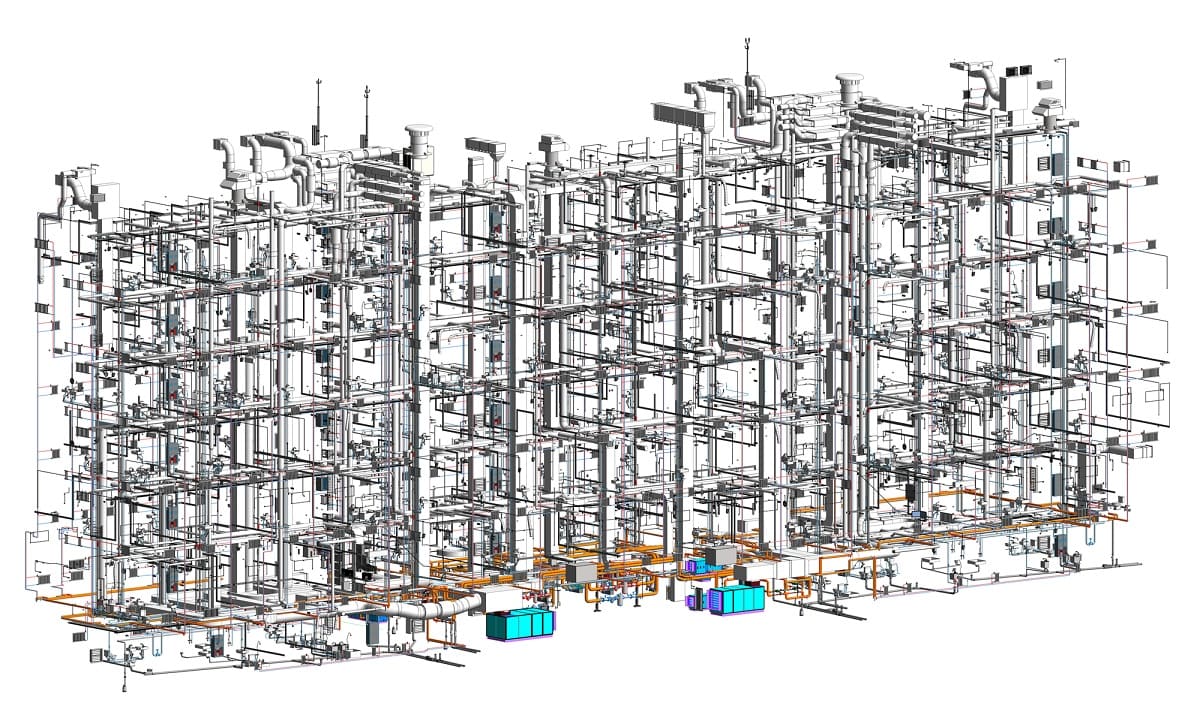Home>diy>Architecture & Design>What Is The Difference Between Local And General Notes On A Blueprint


Architecture & Design
What Is The Difference Between Local And General Notes On A Blueprint
Modified: December 7, 2023
Learn the distinction between local and general notes on a blueprint in architecture design. Gain insights into their importance and how they impact the construction process.
(Many of the links in this article redirect to a specific reviewed product. Your purchase of these products through affiliate links helps to generate commission for Storables.com, at no extra cost. Learn more)
Introduction
Welcome to the world of architecture and engineering blueprints! When you look at a blueprint, you’ll often notice various annotations and notes scribbled on the page. These notes are crucial in conveying important information about the design, construction, and specifications of a building or structure. However, not all notes on a blueprint hold the same significance or serve the same purpose.
In this article, we’ll explore the difference between local notes and general notes on a blueprint. Understanding these differences can help architects, engineers, and construction professionals better interpret and work with blueprint documents.
So, let’s dive into the details and shed some light on these two types of notes, where they are located, their purposes, and why they are essential in the realm of blueprint design and construction.
Key Takeaways:
- Local notes provide specific, detailed instructions for a particular area or feature, ensuring accurate implementation of the design down to the smallest details. They are crucial for precision and clarity in construction projects.
- General notes offer broader, project-wide guidelines and requirements, promoting consistency and uniformity throughout the construction process. They serve as a comprehensive guide for all stakeholders, ensuring adherence to standardized practices and regulations.
Overview of Blueprint Notes
Before delving into the specifics of local and general notes on a blueprint, let’s first understand the general concept of blueprint notes. Blueprint notes are annotations or written instructions that provide additional information about a particular aspect of the design or construction process.
These notes serve as a means of communication between the architect, engineer, contractor, and any other stakeholders involved in the project. They can cover a wide range of topics, including material specifications, building codes, construction techniques, safety guidelines, and more. Blueprint notes are crucial for ensuring that everyone involved in the project is on the same page and understands the necessary requirements.
Now, let’s shift our focus to local notes.
Local Notes
Local notes on a blueprint refer to specific annotations or instructions that are relevant to a particular area or element of the design. These notes are typically found in close proximity to the area they pertain to, clearly indicating their association with a specific location on the blueprint.
The purpose of local notes is to provide detailed information about a particular aspect of the design or construction process. This may include specific dimensions, material requirements, installation details, or any other pertinent information that is specific to that particular area.
For example, if there is a note specifying the type of flooring material to be used in a specific room of a building, that would be considered a local note. Similarly, if there is a note indicating the height and width of a window in a particular area of the blueprint, that is also an example of a local note.
Local notes are essential because they provide clear and concise information that is directly relevant to the specific area of the design being referenced. They serve as a reminder or instruction for those working on the project, ensuring that the design intent is accurately translated into the final structure.
Next, let’s explore the placement and importance of local notes on a blueprint.
Purpose of Local Notes
The purpose of local notes on a blueprint is to provide detailed instructions and specifications that are specific to a particular area or element of the design. These notes play a vital role in ensuring that the design intent is accurately reflected in the final construction.
One of the main purposes of local notes is to clarify any specific requirements or details that may not be immediately evident from the visual representation of the blueprint. While the drawings themselves provide a general overview of the design, local notes offer additional information that is necessary for proper execution.
Local notes often address technical aspects of the design, such as material specifications, installation methods, or construction techniques. They can provide information on the specific measurements, tolerances, or finishes required for a particular element.
Additionally, local notes may include references to codes or regulations that need to be followed for a specific area or feature. These notes ensure that the design complies with local building codes and regulations, guaranteeing the safety and functionality of the structure.
By including local notes on a blueprint, architects and engineers can effectively communicate their design intent to contractors and construction teams. These notes help eliminate any ambiguity or confusion, ensuring that the construction process proceeds smoothly and according to the desired specifications.
Now that we understand the purpose of local notes, let’s explore their placement on a blueprint and why they are crucial for successful implementation of the design.
Placement of Local Notes
The placement of local notes on a blueprint is critical for clarity and ease of reference. Architects and engineers carefully position local notes near the specific area or element to which they correspond. This ensures that anyone reviewing the blueprint can quickly locate and understand the information provided.
Local notes are typically placed close to the corresponding feature or component on the blueprint. For example, if there is a note regarding the type of roofing material to be used, it will likely be placed near the roof section of the blueprint. Similarly, if there is a note regarding the dimensions and specifications of a particular door, it would be positioned close to the door symbol or drawing.
Proper placement of local notes enhances the readability of the blueprint and minimizes any confusion or misinterpretation. It allows contractors and construction teams to easily identify the specific requirements associated with a particular area, element, or feature, without having to search through the entire document.
In addition to their physical placement, local notes are often labeled or numbered to provide further organization and ease of reference. These labels or numbers correspond to a legend or key that provides a comprehensive overview of all the local notes present on the blueprint.
The clarity and accessibility of local notes directly impact the efficiency and accuracy of the construction process. Contractors and construction teams rely on these notes to ensure that they are following the specified guidelines and requirements for each area or component of the design.
In the next section, we will discuss the importance of local notes and how they differ from general notes on a blueprint.
Importance of Local Notes
Local notes play a crucial role in the successful implementation of a design and construction project. They are essential for several reasons:
1. Clarity and Accuracy: Local notes provide clear and specific instructions for a particular area or element of the design, ensuring that there is no confusion or ambiguity during the construction phase. Contractors and construction teams can reference these notes to accurately execute the design intent.
2. Compliance with Regulations: Local notes often include references to building codes, regulations, or industry standards that must be followed for a specific area or feature. By adhering to these requirements, the design remains compliant with safety and structural regulations.
3. Coordination and Collaboration: Local notes facilitate coordination and collaboration among different teams involved in the project. Contractors, subcontractors, and suppliers can easily understand the requirements for their respective areas of work and ensure that they align with the overall design.
4. Efficiency in Decision Making: Local notes contribute to efficient decision-making processes. When challenges or changes arise during construction, having clear and detailed notes helps the project team make informed decisions and implement necessary modifications without any delay.
5. Documentation and Record-Keeping: Local notes serve as a form of documentation, preserving crucial information about specific design decisions, requirements, and specifications. They become a valuable resource for future reference during maintenance, renovations, or potential expansions of the structure.
Now, let’s dive into the concept of general notes on a blueprint and how they differ from local notes.
General Notes
General notes on a blueprint refer to annotations or instructions that provide broad information and apply to multiple areas or elements of the design. Unlike local notes, which are specific to a particular location, general notes encompass more general guidelines or requirements applicable to the entire project.
These notes are typically found in a dedicated section of the blueprint, separate from the specific drawings or diagrams. They may appear at the beginning of the document or towards the end, depending on the blueprint’s layout and organization.
The purpose of general notes is to convey overarching information that applies uniformly throughout the design. They address various aspects of the project, such as construction methods, sustainability requirements, quality control procedures, or specific design considerations.
Examples of general notes could include instructions on how to handle hazardous materials, guidelines for energy-efficient construction practices, requirements for fire safety systems, or guidelines for accessibility compliance. These notes provide essential guidance that impacts the overall construction process and ensures the project meets the necessary standards and regulations.
General notes are typically written in a concise, standardized format, using standardized language and terminology. This consistency allows the information to be easily understood and applied by all parties involved in the project, including architects, engineers, contractors, and subcontractors.
The inclusion of general notes on a blueprint is crucial for maintaining consistency and ensuring that critical project-wide requirements are clearly communicated to all stakeholders. These notes serve as a central reference point for understanding and implementing key project guidelines, enhancing communication and collaboration throughout the design and construction process.
Now that we have defined general notes, let’s explore their placement on a blueprint and discuss their importance in the overall blueprint documentation.
Purpose of General Notes
The purpose of general notes on a blueprint is to provide overarching instructions, guidelines, and important information that apply to the entire project. These notes serve several purposes and are essential for the successful execution of the design and construction process.
1. Standardization and Consistency: General notes ensure that all parties involved in the project are aware of and adhere to standardized guidelines and requirements. They promote consistency in construction methods, materials, safety protocols, and other project-wide considerations, ensuring a unified approach throughout the project.
2. Compliance with Regulations and Codes: General notes often address legal and regulatory requirements that must be met throughout the construction process. These notes ensure that the design and construction are compliant with local building codes, environmental regulations, accessibility standards, and other applicable laws.
3. Safety Considerations: General notes provide important safety-related instructions and precautions that must be followed throughout the project. This includes information on handling hazardous materials, proper use of personal protective equipment (PPE), and adherence to safety protocols to mitigate potential risks on the construction site.
4. Project-Specific Requirements: General notes convey project-specific requirements that go beyond the scope of individual elements or areas. For example, they may outline specific quality control procedures, testing processes, or documentation requirements that need to be followed during construction.
5. Alternative Solutions or Approaches: General notes can also suggest alternative solutions or approaches when certain design elements or materials may not be feasible or available. These notes provide flexibility, allowing project teams to make informed decisions based on the specific circumstances without deviating from the overall project goals.
By including general notes on a blueprint, architects, engineers, and contractors can ensure that everyone involved is working towards a common understanding and objective. These notes provide essential guidance and information that governs the overall construction process and helps to navigate challenges effectively.
Now that we understand the purpose of general notes, let’s explore their placement on a blueprint and discuss the significance of these notes in the context of blueprint documentation.
Placement of General Notes
The placement of general notes on a blueprint is typically in a dedicated section separate from the specific drawings or diagrams. This section may appear at the beginning of the blueprint document or towards the end, depending on the document’s layout and organization.
General notes are often grouped together and presented in a structured format, making them easily noticeable and accessible. They may be listed in a bulleted or numbered format, allowing for quick reference and identification.
Architects, engineers, and blueprint designers strategically position the general notes section to ensure that it catches the attention of all stakeholders reviewing the document. Placing the general notes at the beginning of the blueprint establishes a clear foundation and sets the context for the project. Alternatively, placing them at the end allows the reader to first understand the project details before delving into the general instructions and guidelines.
Additionally, general notes are typically organized in a logical order that follows the flow of the construction process. This ensures that the information is presented in a coherent manner, guiding the reader through the project requirements from start to finish.
The clarity and accessibility of general notes on a blueprint are crucial for their effectiveness. Contractors, subcontractors, and construction teams rely on these notes to understand the overall project-wide guidelines and requirements. Placing the general notes section prominently in the blueprint enables all stakeholders to easily locate, interpret, and adhere to the essential information throughout the construction process.
In addition to their placement, general notes are often labeled or numbered for further organization and clarity. This labeling system allows users to refer to specific notes quickly by corresponding with a legend or key that clarifies the meaning or purpose of each note.
Now that we understand the placement significance, let’s explore the comparison between local and general notes on a blueprint.
Importance of General Notes
General notes on a blueprint serve a crucial role in ensuring that the construction project follows consistent guidelines and meets specific requirements. Here are some reasons why general notes are important:
1. Uniformity and Consistency: General notes set the standard for the entire project, ensuring that all aspects are executed in a consistent manner. They establish guidelines for construction methods, materials, quality control, safety practices, and other key considerations, resulting in a unified approach throughout the project.
2. Compliance with Regulations: General notes often address legal and regulatory requirements that apply to the entire project. By including these notes, architects and engineers can ensure that the design and construction meet all necessary building codes, environmental regulations, accessibility standards, and other applicable laws.
3. Communication and Documentation: General notes serve as an effective means of communication between the design team, contractors, subcontractors, and other stakeholders. They provide essential guidance and instructions that facilitate collaboration, minimize misunderstandings, and ensure that everyone is working towards the same project goals. Additionally, general notes help document important information for future reference during maintenance, renovations, or expansions.
4. Time and Cost Savings: General notes contribute to streamlined decision-making processes, as they provide project-wide guidelines and requirements. By having these notes in place, project teams can make informed decisions, avoid unnecessary delays, and minimize costly errors or rework.
5. Flexibility and Adaptability: General notes allow for flexibility and adaptation to changing circumstances. They can provide alternative solutions or approaches when design elements or materials may not be feasible or available. This flexibility ensures that the project can be adjusted if unforeseen challenges arise during construction.
Now, let’s move on to comparing local and general notes on a blueprint to understand their key differences in terms of content, application, and interpretation.
Local notes on a blueprint are specific to a particular part or feature, while general notes apply to the entire drawing. Use local notes to provide detailed information about a specific area, and general notes for overall instructions or specifications.
Differences in Content
When comparing local notes and general notes on a blueprint, one of the key differences lies in their content. Local notes provide specific information that pertains to a particular area or element of the design, while general notes encompass broader instructions and guidelines that apply to the entire project.
Local Notes:
Local notes are highly specific and detailed. They typically include information such as dimensions, materials, installation requirements, or other specific instructions that are unique to a particular area or feature of the design. These notes provide clear directives for contractors to follow when implementing the design.
Examples of local notes may include:
- Specific material specifications for a flooring type in a specific room.
- Detailed installation instructions for a specific HVAC system.
- Specific placement and dimensions of windows or doors in certain areas.
General Notes:
General notes, on the other hand, cover a broader scope and address project-wide considerations. They provide overarching guidelines, requirements, and instructions that are applicable to multiple areas or features of the design. These notes outline the project’s overall goals, standards, and specific requirements that must be followed by all parties involved.
Examples of general notes may include:
- General safety guidelines and requirements for the entire construction site.
- Sustainability standards to be followed throughout the project.
- Quality control procedures to ensure consistent workmanship.
- Project-specific documentation and reporting requirements.
The content of local and general notes on a blueprint clearly demonstrates how they differ in terms of specificity and breadth of coverage. Local notes focus on the precise requirements for a particular area or feature, while general notes establish the overall framework and guidelines that govern the entire project.
Next, let’s explore the differences in the application and interpretation of local and general notes on a blueprint.
Differences in Application
The application of local and general notes on a blueprint differs in terms of their scope, implementation, and how they are referenced and utilized by the various stakeholders involved in the construction project.
Local Notes:
Local notes have a narrower application and are specifically relevant to the corresponding area or element of the design. They provide detailed instructions and specifications that contractors and subcontractors must follow when working on a specific location or feature within the blueprints.
Contractors and construction teams closely refer to the local notes while carrying out their tasks in a particular area. These notes guide them on the specific requirements, dimensions, materials, or installation techniques necessary for that specific location. Local notes ensure accurate implementation of the design’s intent down to the smallest details.
General Notes:
General notes, on the other hand, have a broader application and serve as a comprehensive guide for the entire project. They encompass project-wide guidelines, requirements, and instructions that need to be followed throughout the construction process.
General notes are referenced by all stakeholders involved in the project, including architects, engineers, contractors, and subcontractors. These notes provide guidance on the overall construction methods, safety protocols, quality control processes, and other project-wide considerations. They ensure consistency and uniformity in the execution of the design across all areas and features within the blueprint.
While local notes are predominantly used by contractors working on specific areas, general notes are consulted by all parties involved to maintain a shared understanding of project requirements and guidelines.
Next, we will further explore the differences in the interpretation of local and general notes on a blueprint.
Differences in Interpretation
When it comes to interpretation, local notes and general notes on a blueprint differ in their level of specificity and the extent to which they require individual judgment or application.
Local Notes:
Local notes are highly specific and leave little room for interpretation. They provide explicit instructions, dimensions, and requirements that must be followed precisely. Contractors and construction teams can interpret local notes straightforwardly, as they provide clear directives for executing the specific area or feature they pertain to.
However, it is essential that contractors accurately understand and implement the information provided in local notes to ensure the successful realization of the design. Any misinterpretation or deviation from the note’s instructions can lead to errors or inconsistencies in the final construction.
General Notes:
General notes, while still providing guidance and requirements, may require some degree of interpretation. They often outline project-wide guidelines or procedures that allow for flexibility in execution. These notes provide overarching principles that may need to be adapted to the specific conditions or challenges encountered during construction.
Interpreting general notes often involves considering the context of the project, understanding the intent behind the instructions, and applying them appropriately to the specific circumstances. The interpretation of general notes may vary depending on the individual’s perspective, expertise, or experience within the construction industry.
Collaboration and communication among the project team are vital to ensure a consistent and accurate interpretation of the general notes. It’s important for all stakeholders to stay aligned and address any potential questions or ambiguities that may arise during the construction process.
Overall, while local notes offer specific and precise guidance, general notes require some level of interpretation and application based on the project’s context and variables.
Conclusion
Understanding the difference between local notes and general notes on a blueprint is crucial for architects, engineers, contractors, and all other stakeholders involved in a construction project. While local notes provide specific instructions and details for a particular area or feature, general notes offer broader guidelines and requirements that span the entire project.
Local notes ensure accurate implementation of the design in specific areas, while general notes establish the framework and standards that govern the overall construction process. Both types of notes play significant roles in ensuring that the design intent is effectively communicated and executed.
By incorporating clear and concise local notes and comprehensive general notes, blueprint documents become valuable tools for effective project coordination, communication, and collaboration. These notes enhance clarity, improve construction efficiency, and ensure compliance with regulations and standards.
Understanding the content, application, and interpretation of local and general notes allows all stakeholders to work together seamlessly, ensuring that the design intent is successfully realized, and the project is completed to the highest quality standards.
Frequently Asked Questions about What Is The Difference Between Local And General Notes On A Blueprint
Was this page helpful?
At Storables.com, we guarantee accurate and reliable information. Our content, validated by Expert Board Contributors, is crafted following stringent Editorial Policies. We're committed to providing you with well-researched, expert-backed insights for all your informational needs.












0 thoughts on “What Is The Difference Between Local And General Notes On A Blueprint”